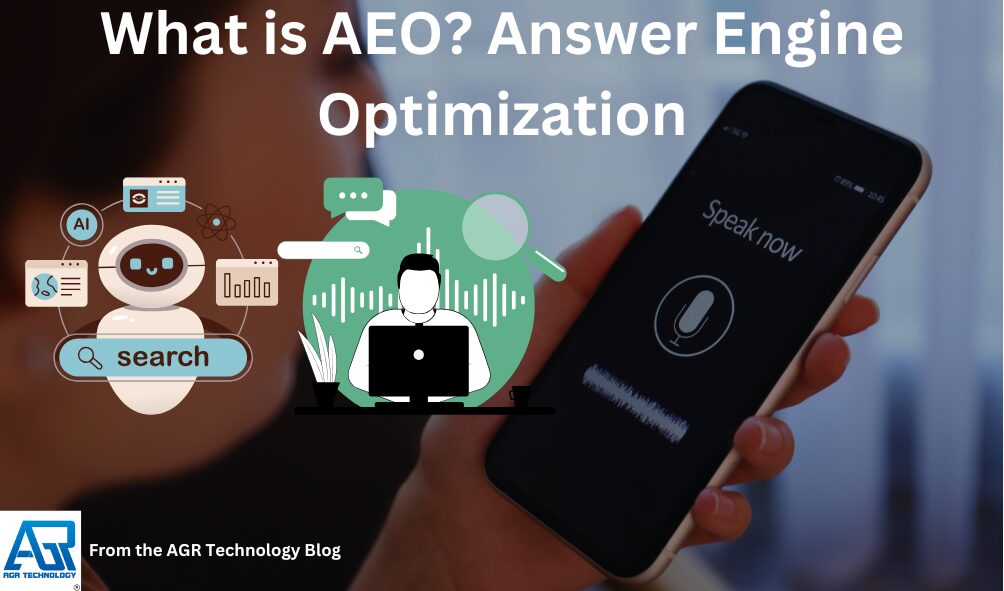In the rapidly evolving digital landscape, Answer Engine Optimization (AEO) has emerged as a critical strategy for content creators. AEO is the process of improving website content to provide direct answers to user queries, making it perfect for Google’s Rich Snippets, Featured Snippets, and “People also ask” sections. But it’s not just about Google anymore.
With the widespread adoption of AI technologies like ChatGPT, Bard, and voice assistants such as Siri and Alexa, AEO has never been more important. Unlike traditional SEO that focuses primarily on ranking in search results, AEO targets optimization for answer engines that deliver immediate, concise responses to specific questions. These AI-driven platforms are transforming how users find information online, shifting from keyword searches to conversational queries.
Need help ranking your website in traditional search engines as well as AI platforms? Contact AGR Technology
What Is Answer Engine Optimization (AEO)?

Answer Engine Optimization (AEO) or Generative Engine Optimization (GEO) is the strategic process of optimizing website content to provide direct answers to user queries. Unlike traditional SEO that focuses on ranking in search results pages, AEO targets AI-driven platforms that deliver immediate, concise responses to users’ questions.
AEO has become crucial with the rise of virtual assistants like Alexa and Siri, AI chatbots such as ChatGPT, and search features like Google’s Rich Snippets and “People also ask” sections. These technologies function as answer engines, extracting specific information from content to directly address user inquiries.
The primary goal of AEO is to structure content in a way that’s easily interpretable by AI systems while providing precise, relevant information that satisfies user intent. This approach requires clear formatting, question-focused content, and concise, authoritative answers that answer engines can easily extract and present to users.
As search behavior shifts from keyword-based queries to conversational questions, especially through voice search, AEO helps businesses ensure their information is discoverable when customers interact with these increasingly popular platforms. By implementing effective AEO strategies, businesses can improve visibility in direct answer formats, establishing themselves as trusted information sources while driving targeted traffic to their websites.
The Difference Between AEO and SEO

(Example of a search result within Google search which triggers AI overviews which synthesize information from a variety of sources and presents snippets to end-users)
AEO (Answer Engine Optimization) and SEO (Search Engine Optimization) share the common goal of improving online visibility, but they differ significantly in their approach, execution, and target platforms.
Core Focus and Purpose
AEO focuses specifically on answering user queries directly and comprehensively. It optimizes content to provide concise, accurate responses that answer engines can easily interpret and display as featured snippets, knowledge panels, or voice responses. AEO targets question-based and long-tail keywords to match user intent precisely.
SEO has a broader scope, aiming to improve a website’s ranking on search engine results pages (SERPs) for a wide range of queries. It encompasses various strategies including keyword optimization, link building, technical improvements, and content creation to increase organic traffic across multiple search platforms.
Target Platforms and Content Formatting
| AEO | SEO |
|---|---|
| Targets answer engines and AI-driven platforms | Targets traditional search engines like Google and Bing |
| Optimizes for featured snippets and direct answers | Optimizes for higher rankings across entire SERPs |
| Focuses on question-based formats | Addresses various content types and formats |
| Prioritizes concise, direct responses | Encompasses longer-form content and diverse media |
Keyword Strategy and Content Structure
AEO demands content structured around specific questions with clear, direct answers. Content must be formatted in ways that make it easy for answer engines to extract and present information. This includes properly structured FAQs, clear headings, and concise explanations.
SEO utilizes a more diverse keyword strategy, including short-tail, long-tail, and informational keywords. Content structure varies widely from blog posts and guides to product pages and videos, all contributing to overall domain authority and visibility.
Combined Strategy Benefits
Implementing both AEO and SEO creates a comprehensive digital marketing approach. This dual strategy optimizes content for traditional search results while simultaneously positioning your business to capture visibility in direct answer formats. As search behavior evolves toward more conversational queries, especially through voice search, implementing AEO alongside traditional SEO becomes increasingly valuable.
Need expert help implementing an effective AEO and SEO strategy for your business? Contact AGR Technology today for a customized digital marketing solution that drives targeted traffic and positions your brand as an authoritative information source in your industry.
Why Answer Engine Optimization Matters

Increased Visibility and Brand Exposure
Answer engine optimization dramatically increases your digital visibility by positioning your content directly in response to user queries. When your business appears in answer boxes, featured snippets, and voice search results, you gain immediate exposure to potential customers. This prime positioning drives qualified traffic to your website without requiring users to scroll through multiple search results.
Enhanced User Experience
Answer engines deliver exactly what modern users want—instant, accurate information without the hassle of sifting through multiple websites. By structuring your content for AEO, you’re meeting users at their exact moment of need with precise answers to their questions. This improved user experience creates positive brand associations and builds trust with your audience. Users who receive direct answers are more likely to engage further with your brand.
Competitive Advantage
As AI-driven search continues to evolve, businesses that adopt AEO early gain significant competitive advantages. While many companies still focus exclusively on traditional SEO, implementing comprehensive answer engine optimization positions you ahead of competitors in AI-powered search environments. This forward-thinking approach establishes your brand as an authoritative industry voice and captures market share in emerging search channels.
Cost-Effective Marketing Strategy
AEO delivers exceptional ROI compared to many digital marketing tactics. By focusing on structured data, clear question-answer formats, and authoritative content, you’re investing in sustainable visibility that doesn’t rely on paid advertising. Once your content is optimized for answer engines, it continues working for your business around the clock, answering customer questions and generating leads without ongoing costs.
Adaptation to Evolving Search Behavior
Search behavior has fundamentally shifted toward conversational queries and voice search. Today’s users ask complete questions rather than typing fragmented keywords, and 65% of 25-49 year-olds speak to their voice-enabled devices daily. By implementing AEO strategies, you’re aligning your digital presence with these evolving search patterns and future-proofing your business against continuing changes in search technology.
Key Components of an Effective AEO Strategy

An effective Answer Engine Optimization strategy combines several critical elements to maximize visibility in AI-driven search environments. These components work together to ensure content delivers direct answers to user queries while maintaining authority and relevance.
Optimizing for Featured Snippets
Featured snippets appear at position zero in search results, providing immediate answers to user queries. To optimize for these valuable snippets:
- Format content strategically using paragraphs, lists, tables, and definitions that directly address specific questions
- Include relevant FAQs throughout website content that mirror how real users phrase their questions
- Structure answers concisely within 40-60 words, as search engines prefer direct, digestible responses
- Use heading tags (H2, H3, H4) to organize content in a logical hierarchy that answer engines can easily interpret
- Add compelling calls-to-action that encourage users to click through for more information, addressing the challenge of “too good” snippets that fully satisfy queries without generating clicks
- Incorporate proactive Generative AI reputation management: Ensure your brand is well positioned by regularly securing reviews and establishing branded profiles on quality websites.
Creating quality content that’s accurate, reliable, and up-to-date significantly increases the likelihood of securing featured snippet positions.
Voice Search Optimization
Voice search optimization captures the conversational nature of how people interact with AI assistants. Approximately 58% of consumers use voice search to find local businesses, making this optimization crucial:
- Incorporate conversational language that mirrors natural speech patterns rather than typed queries
- Focus on question-based formats beginning with who, what, where, when, why, and how
- Target long-tail keywords that match specific voice queries
- Prioritize local SEO by optimizing for “near me” searches and location-based queries
- Update business information consistently across online directories and listings
- Create comprehensive FAQ sections that address common user questions in natural language
The conversational tone of voice queries requires content that sounds like how real people speak and ask questions, not how they type search terms.
Structured Data Implementation
Structured data provides context to search engines by explicitly labeling content elements. This machine-readable format helps answer engines understand and extract information:
- Implement schema markup to categorize content by type (FAQ, How-to, Product, Recipe, etc.)
- Tag question and answer pairs using FAQPage schema to highlight direct responses
- Include HowTo markup for step-by-step instructional content
- Add review schema to build credibility and authority signals
- Structure content with clear headings that follow a logical progression
- Apply table markup for data presentation that answer engines can easily extract
Natural language processing (NLP) benefits significantly from structured data implementation, as it creates a framework that helps AI systems accurately interpret content meaning and context.
How to Implement AEO For Your Website
Implementing Answer Engine Optimization (AEO) requires strategic content development focused on providing direct answers to user queries. By following these specific implementation strategies, your website can effectively capture visibility in AI-powered search results and answer boxes.
Identifying Common Questions
Identifying common questions begins with comprehensive keyword research specifically targeting query-based searches. Tools like Google Keyword Planner, AnswerThePublic, and “People Also Ask” sections reveal the exact questions your audience is asking. Create a structured database of these queries, categorizing them by search intent (navigational, informational, transactional, or commercial). Monitor question patterns through analytics tools to identify emerging topics, and analyze competitors’ FAQ sections to discover potential content gaps. This research forms the foundation for creating targeted content that directly addresses user inquiries in a format answer engines can easily interpret.
Creating Intent-Focused Content
Intent-focused content addresses specific user questions with direct, authoritative answers. Structure your content using a question-and-answer format, placing the most important information at the beginning of each section. Include clear headings that mirror common search queries, and organize content in short paragraphs, bullet points, and numbered lists to improve readability. Create content that satisfies the four main types of search intent—navigational, informational, transactional, and commercial—by understanding the motivation behind each query. Front-load value by providing immediate answers before elaborating with additional context, examples, or supporting information. This approach not only satisfies users seeking quick information but also signals to answer engines that your content directly addresses specific questions.
Enhancing Schema Markup
Schema markup provides search engines with structured data that defines your content’s context and meaning. Implement FAQ schema for question-based content, allowing search engines to identify and extract precise answers from your website. Use HowTo schema for instructional content, Article schema for news or blog content, and Product schema for e-commerce pages—each providing specific information that answer engines can interpret. Schema markup increases the likelihood of your content appearing in featured snippets, knowledge panels, and direct answer boxes. At AGR Technology, we implement comprehensive schema markup solutions that enhance your content’s visibility across AI-powered search results. Contact our team today to develop a customized schema strategy that positions your website as an authoritative source for answer engines.
Challenges in Answer Engine Optimization
Answer Engine Optimization (AEO) presents unique obstacles compared to traditional SEO practices. Understanding these challenges helps businesses develop more effective strategies for AI-powered search platforms.
The “Too Good” Answer Dilemma
Creating perfect answer snippets presents a paradox for content creators. When an answer engine provides a complete response to a user’s query directly in the results, users may not click through to the source website. This phenomenon can:
- Decrease website traffic despite increased visibility
- Reduce conversion opportunities
- Limit brand engagement beyond the initial answer
To counteract this, we incorporate compelling calls-to-action and hint at valuable additional information available on the full page. Phrases like “Discover expert tips and exclusive content in our full guide” encourage users to explore beyond the snippet.
Technical Implementation Complexities
Optimizing for answer engines requires specialized technical expertise in:
- Schema markup implementation
- Structured data formatting
- AI-readable content architecture
- Mobile compatibility enhancements
Without these technical foundations, even excellent content may fail to appear in answer engines. Our team at AGR Technology specializes in these technical optimization aspects, ensuring your website meets the strict requirements of AI-driven search platforms.
Authority Building Requirements
Answer engines prioritize authoritative sources, making reputation development essential. Building sufficient authority requires:
- Consistent high-quality content creation
- Strategic backlink acquisition from trusted sources
- Broader digital footprint across reputable platforms
- Establishment of subject matter expertise
- Securing media placements on high quality publications
This authority-building process takes time and requires coordinated effort across multiple digital channels.
Contact AGR Technology today for a comprehensive AEO strategy that addresses these challenges and positions your business for success in AI-driven search environments.
Measuring AEO Success
Measuring the effectiveness of your Answer Engine Optimization efforts requires specific tracking methods and key performance indicators (KPIs). Unlike traditional SEO metrics, AEO success often manifests in different ways that reflect its unique focus on providing direct answers.
Key Performance Indicators for AEO
AEO performance measurement centers on visibility and user engagement metrics. Featured snippet appearances track how often your content secures the coveted “position zero” in search results. Voice search result frequency measures when your content is selected as the answer for voice queries through assistants like Alexa or Siri.
Engagement metrics reveal deeper insights into AEO effectiveness:
- Click-through rates from featured snippets
- Time spent on page after arriving from an answer box
- Conversion rates from answer-driven traffic
- Bounce rates from answer engine referrals
Tracking Tools and Analytics
Google Search Console provides valuable data for monitoring AEO performance. Its Performance Report shows which queries trigger your content in featured snippets and “People Also Ask” sections. The Coverage Report identifies structured data implementation issues affecting answer visibility.
Analytics platforms offer complementary insights:
- Google Analytics for tracking traffic patterns from answer engines
- SEMrush for monitoring featured snippet rankings
- Ahrefs for identifying answer box opportunities
- STAT for tracking SERP feature changes
ROI Calculation for AEO Strategies
AEO investment delivers quantifiable returns through increased visibility and quality traffic. Calculating ROI involves comparing pre- and post-implementation metrics:
The true value of AEO extends beyond direct conversions. Brand authority improvements and reduced customer service inquiries represent significant but less tangible benefits that contribute to long-term business growth.
At AGR Technology, we implement comprehensive AEO analytics solutions that capture both immediate traffic improvements and long-term brand authority benefits. Our customized tracking dashboards provide clear visibility into how your answer optimization efforts translate into business results. Contact our team today for a detailed AEO performance assessment that identifies your biggest opportunities for gaining visibility in answer-driven search experiences.
The Future of Answer Engine Optimization
Answer Engine Optimization is rapidly evolving alongside advancements in AI technology. As voice assistants and AI chatbots become more sophisticated, businesses must adapt their content strategies to maintain visibility in this changing landscape.
Emerging Trends in AEO
The future of AEO centers on three key developments: multimodal search, conversational AI enhancements, and semantic understanding. Voice search continues to grow in popularity, with 71% of consumers preferring voice search over typing. This shift requires content that answers questions naturally and conversationally.
AI engines are becoming increasingly capable of understanding context, user intent, and delivering personalized responses. These systems now analyze user location, search history, and preferences to provide tailored answers rather than generic information.
Preparing Your Business for the Next Generation of AI Search
Businesses need concrete strategies to stay ahead in the AEO landscape:
- Create purpose-built FAQ content that directly addresses common customer questions
- Implement comprehensive schema markup across all website content
- Develop voice-friendly content using natural language patterns
- Build topical authority through interconnected content clusters
These approaches help position your content as the authoritative source that AI engines choose to feature in direct answers.
How AGR Technology Can Help You Succeed with AEO
At AGR Technology, we specialize in comprehensive AEO solutions that prepare your business for current and future answer engines. Our services include:
- Technical AEO audit to identify opportunities and weaknesses in your current content
- Schema implementation tailored to your specific industry and content types
- Content restructuring to maximize answer engine visibility
- Voice search optimization using conversational keyword research
Our team stays at the forefront of answer engine developments, ensuring your business remains visible as search technology evolves. Contact AGR Technology today to future-proof your digital presence with our expert AEO services.
Key Takeaways
- Answer Engine Optimization (AEO) focuses on optimizing content to provide direct answers to user queries for AI platforms like ChatGPT, Google’s Featured Snippets, and voice assistants
- Unlike traditional SEO which aims for general search rankings, AEO specifically targets answer engines that deliver immediate, concise responses to questions
- Effective AEO strategies include optimizing for featured snippets, implementing structured data, creating question-based content, and adapting for voice search
- Businesses implementing AEO gain competitive advantages including increased visibility, enhanced user experience, and adaptation to evolving conversational search behavior
- Measuring AEO success requires tracking featured snippet appearances, voice search results, click-through rates, and conversions from answer-driven traffic
- The future of AEO involves multimodal search capabilities, more sophisticated conversational AI, and greater semantic understanding of user intent
Conclusion
The landscape of search is rapidly evolving with AEO becoming essential for modern digital success. As AI continues to transform how users find information, businesses must adapt their content strategies beyond traditional SEO approaches.
We’re witnessing a fundamental shift toward answer-focused optimization that delivers immediate value to users. By implementing effective AEO strategies now, you’ll position your business at the forefront of this digital revolution.
The future belongs to companies that can provide clear, authoritative answers to user questions across all platforms. It’s time to embrace AEO not just as a supplementary tactic but as a core component of your digital marketing strategy to ensure long-term visibility and growth in an AI-driven world.
Frequently Asked Questions
What is Answer Engine Optimization (AEO)?
Answer Engine Optimization is the strategic process of optimizing website content to provide direct answers to user inquiries, targeting AI-driven platforms like Google’s Rich Snippets, voice assistants, and chatbots. Unlike traditional SEO that focuses on search rankings, AEO aims to structure content in a way that is easily interpretable by AI systems to deliver immediate, concise responses to user questions.
How does AEO differ from traditional SEO?
While both AEO and SEO aim to improve online visibility, they differ in approach. AEO specifically targets answer engines and AI platforms, optimizing for featured snippets and direct answers. SEO focuses on improving rankings on traditional search results pages through a broader range of strategies. AEO emphasizes concise, question-based content, whereas SEO encompasses diverse content types and longer-form media.
Why is AEO becoming increasingly important?
AEO is growing in importance due to the rise of AI technologies like ChatGPT and voice assistants (Siri, Alexa). Modern users increasingly prefer conversational queries and voice searches that deliver immediate answers. Businesses implementing AEO gain increased visibility, enhanced user experience, and competitive advantages. It’s also a cost-effective marketing strategy with exceptional ROI by providing sustainable visibility without paid advertising.
What are the key components of an effective AEO strategy?
An effective AEO strategy includes optimizing for featured snippets through strategic content formatting, implementing relevant FAQs with concise answers, and optimizing for voice search by using natural language and long-tail keywords. Implementing structured data (schema markup) is also crucial as it provides context to search engines, helping them understand and extract information more effectively.
What challenges do businesses face when implementing AEO?
AEO implementation challenges include limited tracking tools, the “too good answer” dilemma (where perfect answers decrease website traffic), and technical complexities. Effective AEO requires specialized expertise in schema markup, structured data, and mobile compatibility. Building authority through high-quality content and strategic backlinks is also challenging, requiring time and coordinated effort across digital channels.
How can businesses measure AEO success?
AEO success metrics differ from traditional SEO. Key performance indicators include click-through rates from featured snippets, time spent on page, conversion rates, and bounce rates. Tools like Google Search Console, Google Analytics, and SEMrush help monitor AEO performance. Businesses should track featured snippet appearances and conversion rate improvements to calculate ROI effectively.
How should businesses prepare for the future of AEO?
To prepare for AEO’s future, businesses should adapt to advancing AI technologies like multimodal search and conversational AI. Creating purpose-built FAQ content, implementing comprehensive schema markup, and developing voice-friendly content are essential strategies. Staying current with AI search developments and regularly updating optimization approaches will ensure continued visibility as digital search landscapes evolve.
What technical elements are most important for AEO?
Schema markup and structured data are the most critical technical elements for AEO. These provide explicit context to search engines about your content’s meaning. Mobile optimization is equally important since voice searches predominantly happen on mobile devices. Page speed, HTML headings hierarchy, and clean code structure also significantly impact how well answer engines can interpret and feature your content.
Related pages:
Source(s) cited:
The impact of voice assistants on consumer behavior: PwC [Online]. Available at: https://www.pwc.com/us/en/services/consulting/library/consumer-intelligence-series/voice-assistants.html (Accessed: 6 April 2025).
Andersen, Derek. “40+ Voice Search Stats You Need to Know in 2025” www.invoca.com/blog/voice-search-stats-marketers. Accessed 6 Apr. 2025.

Alessio Rigoli is the founder of AGR Technology and got his start working in the IT space originally in Education and then in the private sector helping businesses in various industries. Alessio maintains the blog and is interested in a number of different topics emerging and current such as Digital marketing, Software development, Cryptocurrency/Blockchain, Cyber security, Linux and more.
Alessio Rigoli, AGR Technology
![logo-new-23[1] logo-new-23[1]](https://agrtech.com.au/wp-content/uploads/elementor/thumbs/logo-new-231-qad2sqbr9f0wlvza81xod18hkirbk9apc0elfhpco4.png)
